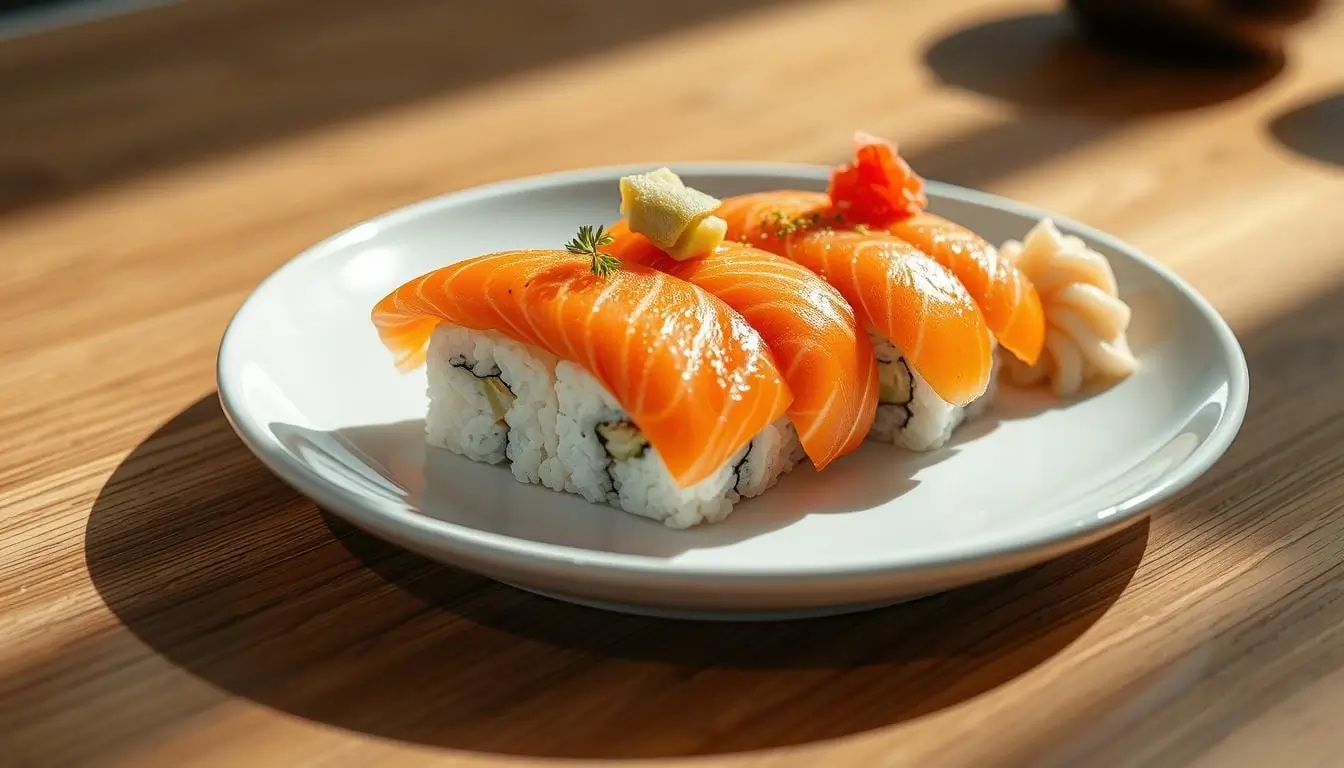Ingredients
Method
- Step 1: Prepare the Sushi RiceRinse the rice: Place rice in a bowl and rinse under cold water until the water runs clear (about 3-4 rinses). This removes excess starch for that perfect sticky texture.
- Cook the rice: Combine rice with 1¼ cups water in a rice cooker or saucepan. Cook according to package instructions. (Pro tip: I always let my rice sit for 10 minutes after cooking to absorb moisture evenly.)
- Season the rice: In a small bowl, mix rice vinegar, sugar, and salt until dissolved. Transfer warm rice to a large, shallow bowl (wooden hangiri is traditional, but any wide bowl works). Gently fold in the vinegar mixture with a wooden spoon, fanning the rice to cool it to body temperature (about 98°F/37°C). Don’t overmix—you want to keep the grains intact.
- Step 2: Prepare the Salmon
- Check for quality: Ensure your salmon is sushi-grade, with a vibrant color and glossy sheen. If it smells fishy, it’s not fresh enough for nigiri.
- Slice the salmon: Using a sharp knife, cut the salmon into thin, uniform slices (about 3x1 inches, ¼-inch thick). Angle your knife at 45 degrees for clean cuts. (I messed this up my first time—uneven slices make for wonky nigiri!)
- Chill the salmon: Keep slices refrigerated until ready to assemble to maintain that firm, cool texture.
- Step 3: Shape the Nigiri
- Wet your hands: Dip your hands in a bowl of water mixed with a splash of rice vinegar to prevent sticking.
- Form rice balls: Scoop about 1-1½ tbsp of rice and gently shape into an oval (about 2 inches long). Press lightly to hold the shape without compacting too much.
- Add wasabi (optional): Dab a tiny amount of wasabi on one side of a salmon slice for a subtle kick.
- Assemble: Place a salmon slice over the rice, gently pressing so it drapes naturally. The fish should slightly overhang the rice for that perfect NYT-style presentation.
- Step 4: Serve
- Plate with care: Arrange nigiri on a clean plate with pickled ginger and a small dish of soy sauce. Add garnishes like shiso or yuzu zest if you’re feeling fancy.
- Serve immediately: Nigiri is best eaten fresh to enjoy the contrast of warm rice and cool salmon.
Notes
Nutrition Information
Per piece (approximate)
- Calories: 60-70 kcal
- Protein: 4g
- Fat: 2g
- Carbohydrates: 8g
- Rice temperature is key: The rice should be warm (body temperature) to contrast with the cold salmon. Too hot, and it’ll start cooking the fish. Too cold, and it loses that soft, sticky vibe.
- Don’t skip the rinse: Rinsing the rice ensures it’s not too starchy, which is critical for that authentic sushi texture.
- Knife skills matter: A sharp, non-serrated knife makes all the difference for clean salmon slices. I learned this after mangling my first batch—trust me, invest in a good knife.
- Sourcing salmon: Look for sushi-grade salmon at reputable fish markets or Asian grocery stores. If you’re unsure about quality, check out my guide to the best canned salmon for tips on evaluating fish quality and sustainability.
- Storage tip: If you’re not eating right away, store rice and salmon separately in the fridge. Assemble just before serving to avoid soggy rice.
- Rice too sticky? You might have overmixed or added too much water. Next time, measure precisely and fold gently.
- Salmon falling off? Your rice balls might be too loose. Press a bit firmer when shaping, but don’t squash them.
- Fish tastes off? Always double-check the freshness of your salmon. If it’s not sushi-grade, don’t risk it.
